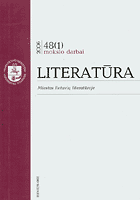VIRGINOS WOOLF ROMANO "BANGOS" FORMA: POLILOGO DALYVIAI
THE FORMAL PROPERTIES OF VIRGINIA WOOLF’S NOVEL“THE WAVES”: POLYLOGUE PARTICIPANTS
Author(s): Linara BartkuvienėSubject(s): Literary Texts
Published by: Vilniaus Universiteto Leidykla
Summary/Abstract: The present article focuses on V.Woolf’s experimentation with narrative and ambitions to pursue a technique able to transgress the boundaries of socio-descriptive Victorian and Edwardian fiction, and to open a dialogue/polylogue for different participants, i.e., for different kinds of literature such as epic, lyric and drama. In the article the arguments are based on the formalist aesthetics of Roger Fry and Clive Bell whose theories had a crucial influence upon Woolf’s writing. Having set the novel within the framework of the postimpressionist paradigm, Woolf extracts the epic, lyric and dramatic elements out of their natural habitat, and misrepresents and distorts them, and employs the so-called “estrangement” method, i.e., Woolf adheres to the postimpressionistic tenets not to merely reproduce and copy the things seen: an artist is expected in some way or other to misrepresent and distort the visual world. Woolf synthesizes arts and achieves a form which encompasses the elements of painting and music altogether. Moreover, not only does “The Waves” enter the polylogue with different kinds of literature, it also resumes a dialogue with (Romantic) tradition and its preoccupation with the inner form as the form which best expresses the depth of spirit, the moments of being.
Journal: Literatūra
- Issue Year: 48/2006
- Issue No: 4
- Page Range: 79-91
- Page Count: 13
- Language: Lithuanian

